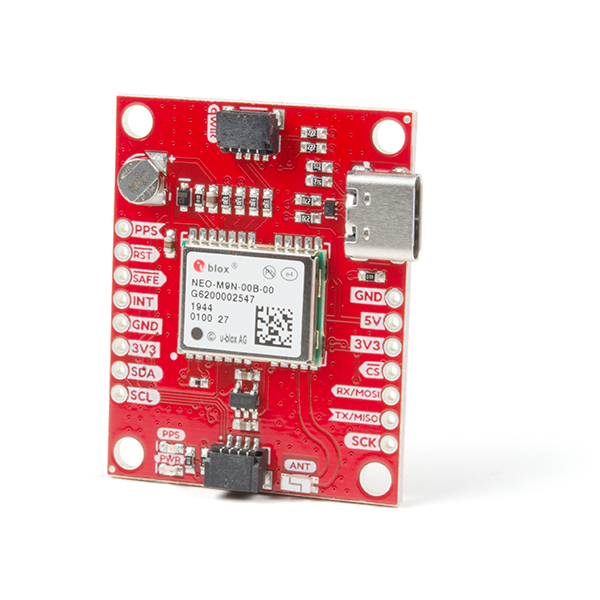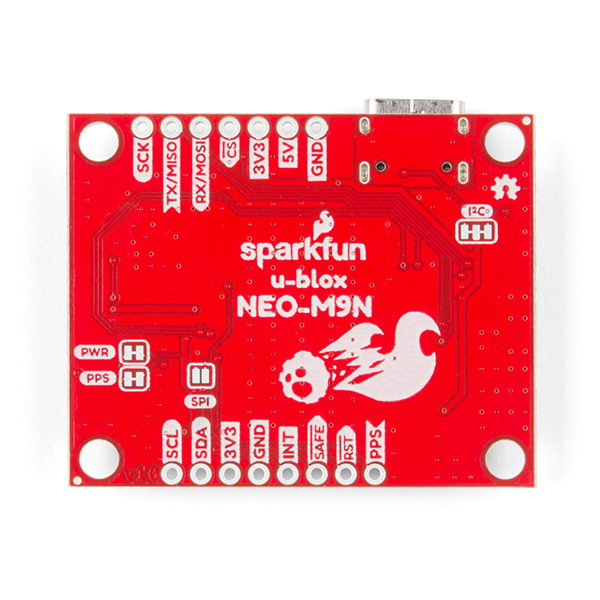SparkFun GPS Breakout - NEO-M9N, Chip Antenna (Qwiic)
The SparkFun NEO-M9N GPS Breakout with on-board chip antenna is a high quality GPS board with equally impressive configuration options. The NEO-M9N module is a 92-channel u-blox M9 engine GNSS receiver, meaning it can receive signals from the GPS, GLONASS, Galileo, and BeiDou constellations witn ~1.5 meter accuracy. This breakout supports concurrent reception of four GNSS. This maximizes position accuracy in challenging conditions, increasing precision and decreases lock time; and thanks to the onboard rechargeable battery, you'll have backup power enabling the GPS to get a hot lock within seconds! Additionally, this u-blox receiver supports I2C (u-blox calls this Display Data Channel) which made it perfect for the Qwiic compatibility so we don't have to use up our precious UART ports. Utilizing our handy Qwiic system, no soldering is required to connect it to the rest of your system. However, we still have broken out 0.1"-spaced pins in case you prefer to use a breadboard.
The NEO-M9N module detects jamming and spoofing events and can reports them to the host, so that the system can react to such events. A SAW (Surface Acoustic Wave) filter combined with an LNA (Low Noise Amplifier) in the RF path is integrated in the NEO-M9N module which allows normal operation even under strong RF interferences.
U-blox based GPS products are configurable using the popular, but dense, windows program called u-center. Plenty of different functions can be configured on the NEO-M9N: baud rates, update rates, geofencing, spoofing detection, external interrupts, SBAS/D-GPS, etc. All of this can be done within the SparkFun Arduino Library!
The SparkFun NEO-M9N GPS Breakout is also equipped with an on-board rechargeable battery that provides power to the RTC on the NEO-M9N. This reduces the time-to-first fix from a cold start (~24s) to a hot start (~2s). The battery will maintain RTC and GNSS orbit data without being connected to power for plenty of time.
The SparkFun Qwiic Connect System is an ecosystem of I2C sensors, actuators, shields and cables that make prototyping faster and less prone to error. All Qwiic-enabled boards use a common 1mm pitch, 4-pin JST connector. This reduces the amount of required PCB space, and polarized connections mean you can’t hook it up wrong.
- Integrated Chip Antenna
- 92-Channel GNSS Receiver
- 1.5m Horizontal Accuracy
- 25Hz Max Update Rate (4 concurrent GNSS)
- Time-To-First-Fix:
- Cold: 24s
- Hot: 2s
- Max Altitude: 80,000m
- Max G: ≤4
- Max Velocity: 500m/s
- Velocity Accuracy: 0.05m/s
- Heading Accuracy: 0.3 degrees
- Time Pulse Accuracy: 30ns
- 3.3V VCC and I/O
- Current Consumption: ~31mA Tracking GPS+GLONASS
- Software Configurable
- Geofencing
- Odometer
- Spoofing Detection
- External Interrupt
- Pin Control
- Low Power Mode
- Many others!
- Supports NMEA, UBX, and RTCM protocols over UART or I2C interfaces
SparkFun GPS Breakout - NEO-M9N, Chip Antenna (Qwiic) Product Help and Resources
SparkFun GPS NEO-M9N Hookup Guide
December 19, 2019
The u-blox NEO-M9N is a powerful GPS unit that comes with a chip antenna, SMA connector, and u.FL connector. We will quickly get you set up using the Qwiic ecosystem and Arduino so that you can start reading the output!
How to Upgrade Firmware of a u-blox GNSS Receiver
March 26, 2021
A few steps and you'll upgrade to the latest features on a u-blox GNSS receiver.
Getting Started with U-Center for u-blox
September 13, 2018
Learn the tips and tricks to use the u-blox software tool to configure your GPS receiver.
Core Skill: Programming
If a board needs code or communicates somehow, you're going to need to know how to program or interface with it. The programming skill is all about communication and code.
Skill Level: Competent - The toolchain for programming is a bit more complex and will examples may not be explicitly provided for you. You will be required to have a fundamental knowledge of programming and be required to provide your own code. You may need to modify existing libraries or code to work with your specific hardware. Sensor and hardware interfaces will be SPI or I2C.
See all skill levels
Core Skill: Electrical Prototyping
If it requires power, you need to know how much, what all the pins do, and how to hook it up. You may need to reference datasheets, schematics, and know the ins and outs of electronics.
Skill Level: Rookie - You may be required to know a bit more about the component, such as orientation, or how to hook it up, in addition to power requirements. You will need to understand polarized components.
See all skill levels
Comments
Looking for answers to technical questions?
We welcome your comments and suggestions below. However, if you are looking for solutions to technical questions please see our Technical Assistance page.
Customer Reviews
3.5 out of 5
Based on 2 ratings:
Latest gen GPS/GNSS with plenty of configuration options
Really powerful tiny GNSS board that supports almost an L1 GNSS system out there. This board delivers the most satellites und any condition. The quiic, usb and header connecters make it usable for many projects.
0 of 3 found this helpful:
Did not work as advertised
I gave it a one star rating but then I changed my mind to give it 2 star rating because nothing was burned.
I bought the Redboard Turbo card and this GPS Breakout. I used the program provided by Sparkfun for this GPS Breakout board. I got all the drivers loaded and compiled. The Sparkfun Redboard Turbo card and the COM port were selected properly. The program loaded ok via Arduino IDE. But nothing worked. The output of the COM port was garbage. It did not even output the first Serial.println("SparkFun Ublox Example"). I tried to trouble shoot it. But nothing worked. I gave up. THIS PRODUCT DOES NOT WORK AS ADVERTISED.
The provided example code was not written for use with the RedBoard Turbo, give an Arduino Uno or a SparkFun RedBoard Qwiic a try and everything should work just fine for you. If you need additional help, please contact our technical assistance team.





One of the things that wasn't clear to me was whether the USB connector was just for power or whether it would work to interface the module to a Windows computer with just the USB cable. Unfortunately nothing in the hookup guide or the specs seems to mention the USB functionality to answer this question.
Well, I went ahead and bought one (the chip antenna version) through the SparkFun Store on Amazon (which actually had the chip-antenna version in stock unlike the SparkFun website) and I am happy to say that it works just fine with just a USB-C connection, and no special drivers were required in Windows 10 which immediately identified it at a u-blox GPS Receiver and set it up as a new COM port. u-center works great with it, and I'm currently looking at a 27 satellite position solution using all four GNSS systems plus SBAS differential corrections. This is the default out-of-the-box configuration.
So I can highly recommend these NEO-M9N modules, and they're one of the few "everything-L1" products that is readily available and easy to use. I would write a five-star review, but they don't seem to let you write a review if you didn't buy directly from the web site.
I also soldered upward pointing header pins to both rows of connection points and was able to connect it using a USB to TTL 3.3V serial adapter as well.